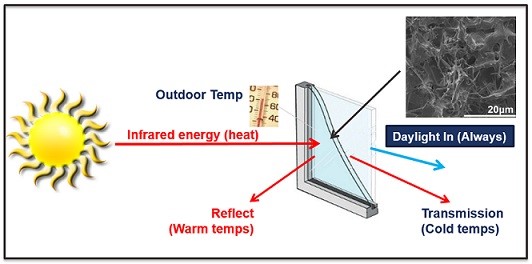Infrared-Switching Nanomaterial
Web Published:
10/22/2019
Nanomaterial compositions that undergo phase transitions from infrared transmissive at low temperatures to infrared reflective at higher temperatures.
One of the major hurdles in energy efficient buildings is excess heat gain from solar light. Current technologies designed to address this problem, also block visible light, thereby, increasing the need for artificial lighting. Furthermore, these products are static across all temperatures, and eliminate solar heat gain in winter. These drawbacks offset the product’s gain. There is a need for technology that optimizes solar heat transmission from infrared light, without reducing the transmission of visible light.
This invention provides doped vanadium oxide nanomaterials that undergo metal-insulator phase transitions at elevated temperatures. The materials have been designed to exhibit such transitions in close proximity to room temperature. When applied to windows, coatings comprising these materials passively block heat gain at high ambient temperatures while permitting heat gain at low ambient temperatures, all without a deleterious effect on transmission of visible light. The phase transition that these materials undergo occurs on a timescale quicker than femtoseconds.

When compared to electrochromic and static metallic coatings, these materials offer a significant cost and energy savings by virtue of their passive, thermally switchable heat-blocking properties as well as the tunability of their switching temperature to meet the needs of different geographic climates, all without significant change in visible light transmittance.
- Energy (windows/fenestration, roofing)
- Textiles
- Paints, stains and coatings
- Computing
- Defense (night vision, missile guidance, electromagnetic cloaking)
US Non-Provisional Patent Application 13/632,674 US20130101848A1 filed October 1, 2012. US Patent Application 10,479,900 US10479900B2 August 26, 2015.
Prototype demonstration.
Available for licensing or collaboration.
Patent Information:
| App Type |
Country |
Serial No. |
Patent No. |
Patent Status |
File Date |
Issued Date |
Expire Date |
|